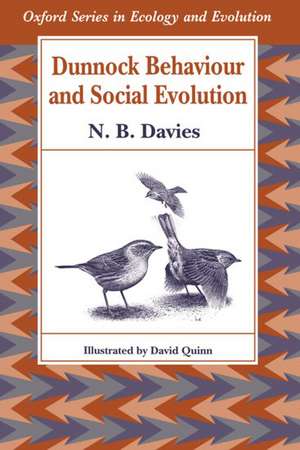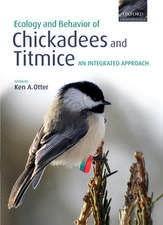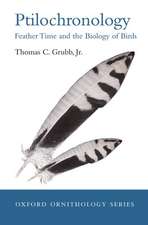Dunnock Behaviour and Social Evolution: Oxford Series in Ecology and Evolution
Autor N. B. Daviesen Limba Engleză Paperback – 20 aug 1992
Din seria Oxford Series in Ecology and Evolution
-
 Preț: 321.54 lei
Preț: 321.54 lei - 25%
 Preț: 502.27 lei
Preț: 502.27 lei - 14%
 Preț: 353.15 lei
Preț: 353.15 lei -
 Preț: 325.98 lei
Preț: 325.98 lei - 18%
 Preț: 459.19 lei
Preț: 459.19 lei - 28%
 Preț: 375.55 lei
Preț: 375.55 lei - 19%
 Preț: 439.25 lei
Preț: 439.25 lei - 13%
 Preț: 443.22 lei
Preț: 443.22 lei - 28%
 Preț: 376.06 lei
Preț: 376.06 lei - 34%
 Preț: 697.21 lei
Preț: 697.21 lei - 9%
 Preț: 296.35 lei
Preț: 296.35 lei - 14%
 Preț: 480.86 lei
Preț: 480.86 lei - 12%
 Preț: 424.74 lei
Preț: 424.74 lei - 18%
 Preț: 356.03 lei
Preț: 356.03 lei - 13%
 Preț: 443.36 lei
Preț: 443.36 lei - 13%
 Preț: 464.12 lei
Preț: 464.12 lei - 41%
 Preț: 139.55 lei
Preț: 139.55 lei - 30%
 Preț: 718.17 lei
Preț: 718.17 lei - 38%
 Preț: 268.41 lei
Preț: 268.41 lei - 30%
 Preț: 590.27 lei
Preț: 590.27 lei - 30%
 Preț: 497.74 lei
Preț: 497.74 lei - 19%
 Preț: 351.87 lei
Preț: 351.87 lei - 18%
 Preț: 360.28 lei
Preț: 360.28 lei - 28%
 Preț: 375.06 lei
Preț: 375.06 lei - 28%
 Preț: 375.73 lei
Preț: 375.73 lei - 34%
 Preț: 802.62 lei
Preț: 802.62 lei - 19%
 Preț: 351.62 lei
Preț: 351.62 lei - 14%
 Preț: 437.87 lei
Preț: 437.87 lei - 30%
 Preț: 550.67 lei
Preț: 550.67 lei - 22%
 Preț: 400.41 lei
Preț: 400.41 lei - 19%
 Preț: 352.29 lei
Preț: 352.29 lei - 18%
 Preț: 354.05 lei
Preț: 354.05 lei - 28%
 Preț: 373.46 lei
Preț: 373.46 lei - 28%
 Preț: 495.10 lei
Preț: 495.10 lei - 8%
 Preț: 299.19 lei
Preț: 299.19 lei - 23%
 Preț: 464.29 lei
Preț: 464.29 lei - 28%
 Preț: 375.06 lei
Preț: 375.06 lei - 30%
 Preț: 592.43 lei
Preț: 592.43 lei
Preț: 377.84 lei
Preț vechi: 519.74 lei
-27% Nou
Puncte Express: 567
Preț estimativ în valută:
72.32€ • 78.58$ • 60.79£
72.32€ • 78.58$ • 60.79£
Carte tipărită la comandă
Livrare economică 09-15 aprilie
Preluare comenzi: 021 569.72.76
Specificații
ISBN-13: 9780198546757
ISBN-10: 0198546750
Pagini: 286
Ilustrații: halftones, line drawings, tables
Dimensiuni: 153 x 235 x 16 mm
Greutate: 0.55 kg
Editura: OUP OXFORD
Colecția OUP Oxford
Seria Oxford Series in Ecology and Evolution
Locul publicării:Oxford, United Kingdom
ISBN-10: 0198546750
Pagini: 286
Ilustrații: halftones, line drawings, tables
Dimensiuni: 153 x 235 x 16 mm
Greutate: 0.55 kg
Editura: OUP OXFORD
Colecția OUP Oxford
Seria Oxford Series in Ecology and Evolution
Locul publicării:Oxford, United Kingdom
Cuprins
Why Dunnocks?; Study species and study area; Population structure and the variable mating system; Territorial behaviour: competition for habitat and mates; Factors influencing an individual's competitive success; Mate guarding and mating: sexual conflict; Relating behaviour to maternity and paternity; Reproductive output from the different mating systems; Individual reproductive success in the various mating systems; Parental effort by males and females in pairs and trios; How males allocate effort between broods in polygyny and polygynandry; Paternity and parental effort; Parasitism by Cuckoos; Sexual conflict, parental care, and mating systems; References; Author and subject index.
Recenzii
`His book is intended primarily for advanced undergraduate or postgraduate courses, but I hope it will encourage students at every level to appreciate that not all research needs high-technology apparatus, that there is much still to be learnt by careful long-term observation, and that members of Britain's fauna can have lives that are as interesting as exotic tropical forms. New Scientist
`Not only is the book fluently written and beautifully illustrated, it is also supremely user-friendly.' ` . . . without such as Nick Davies where would the comparative biologists be?' Times Higher Education Supplement
'useful even to those familiar with his work ... It should be particularly instructive for students, because the work addresses questions typical of the general field of behavioural ecology and demonstrates the value of combining experiment and description.'P.L. Schwagmeyer, University of Oklahoma, Nature
'The organization and integration of these topics makes the book useful even to those familiar with his work. It should be particularly instructive for students.'P.L. Schwagmeyer, University of Oklahoma, Nature, Vol 361, February 1993
`It provides an engaging introduction to current questions about the evolution of mating systems, a model of what can be achieved by a judicious blend of field observation and experimentation, and a salutary reminder that solutions to important problems in behavioural ecology may reside in one's own back yard.' Science
'In this monograph Davies summarizes a decade of work analysing how the different mating systems of dunnocks arise and their social and reproductive consequences. These studies provide the most detailed and convincing analysis to date of the factors that modulate parental effort in birds. ... it provides an engaging introduction to current questions about the evolution of mating systems, a model of what can be achieved by a judicious blend of field observation and experimentation, and a salutary reminder that solutions to important problems in behavioral ecology may reside in one's own back yard.'Robert Gibson, University of California, Science, Vol. 260, April 1993
'Chapters 1 and 2 should be required reading for all those planning field studies in behavioural ecology. ... Davies writes with clarity and logic, and with an evident affection for his birds which will make the complex story accessible and fascinating to a wide readership. ... As a model of study design, hypothesis testing by observation, and experiment, and clarity this book should be read by all interested in ecology, evolution and animal behaviour. Further the results have wide significance and provide a fascinating and entertaining insight into the life of a not-so-typical little brown bird.'Jeremy Wilson, Bird Study Vol 40:2 July 1993
'This book is not typical, it is outstanding. The story is so well written and srtuctured that by the end you are so familiar with the details of the research that you feel you had done it yourself ... the book also conveys the excitement and wonder which come when you start unravelling the private lives of your study species. It is both inspirational and instructive. I urge you to make up your own mind and buy the book: the cost is minimal and the benefits are large. The book is a fascinating insight into a bird which is only dull in appearance.'Ken Norris, Ibis 135, 1993
'It is very readable and due to the many tables and graphs easy to understand, it has a clear overview and scientific at the same time. David Quinn's excellent drawings offer examples of the social behaviour of the dunnock. Attractively priced as well, I have no hesitation in recommending this book to every ornithologist.'Corax (3) 1993
'a detailed review of field and laboratory studies on the dunnock 'Laura Beani, Ethology, Ecology & Evolution, 6:1994
'Impressively complete evidence'Times Literary Supplement
'In this well-written monograph, Davies brings together information from a variety of papers written in the past decade ... Davies book is almost perfect as a focus of, say, graduate seminars in behavioral ecology ... One of the strengths of this monograph is that it shows just what can be accomplished in behavioral ecology working with a population of wild, banded birds. For this reason alone, Davies' book should be exceedingly useful for students planning research projects. I highly recommend Nick Davies' book for all students of bird behavior. Certainly, every university library should have this title in their collection, and behavioral ecologists will want their own copoies.'Randall Breitwisch, University of Dayton, The Auk 111(1) 1994
`Not only is the book fluently written and beautifully illustrated, it is also supremely user-friendly.' ` . . . without such as Nick Davies where would the comparative biologists be?' Times Higher Education Supplement
'useful even to those familiar with his work ... It should be particularly instructive for students, because the work addresses questions typical of the general field of behavioural ecology and demonstrates the value of combining experiment and description.'P.L. Schwagmeyer, University of Oklahoma, Nature
'The organization and integration of these topics makes the book useful even to those familiar with his work. It should be particularly instructive for students.'P.L. Schwagmeyer, University of Oklahoma, Nature, Vol 361, February 1993
`It provides an engaging introduction to current questions about the evolution of mating systems, a model of what can be achieved by a judicious blend of field observation and experimentation, and a salutary reminder that solutions to important problems in behavioural ecology may reside in one's own back yard.' Science
'In this monograph Davies summarizes a decade of work analysing how the different mating systems of dunnocks arise and their social and reproductive consequences. These studies provide the most detailed and convincing analysis to date of the factors that modulate parental effort in birds. ... it provides an engaging introduction to current questions about the evolution of mating systems, a model of what can be achieved by a judicious blend of field observation and experimentation, and a salutary reminder that solutions to important problems in behavioral ecology may reside in one's own back yard.'Robert Gibson, University of California, Science, Vol. 260, April 1993
'Chapters 1 and 2 should be required reading for all those planning field studies in behavioural ecology. ... Davies writes with clarity and logic, and with an evident affection for his birds which will make the complex story accessible and fascinating to a wide readership. ... As a model of study design, hypothesis testing by observation, and experiment, and clarity this book should be read by all interested in ecology, evolution and animal behaviour. Further the results have wide significance and provide a fascinating and entertaining insight into the life of a not-so-typical little brown bird.'Jeremy Wilson, Bird Study Vol 40:2 July 1993
'This book is not typical, it is outstanding. The story is so well written and srtuctured that by the end you are so familiar with the details of the research that you feel you had done it yourself ... the book also conveys the excitement and wonder which come when you start unravelling the private lives of your study species. It is both inspirational and instructive. I urge you to make up your own mind and buy the book: the cost is minimal and the benefits are large. The book is a fascinating insight into a bird which is only dull in appearance.'Ken Norris, Ibis 135, 1993
'It is very readable and due to the many tables and graphs easy to understand, it has a clear overview and scientific at the same time. David Quinn's excellent drawings offer examples of the social behaviour of the dunnock. Attractively priced as well, I have no hesitation in recommending this book to every ornithologist.'Corax (3) 1993
'a detailed review of field and laboratory studies on the dunnock 'Laura Beani, Ethology, Ecology & Evolution, 6:1994
'Impressively complete evidence'Times Literary Supplement
'In this well-written monograph, Davies brings together information from a variety of papers written in the past decade ... Davies book is almost perfect as a focus of, say, graduate seminars in behavioral ecology ... One of the strengths of this monograph is that it shows just what can be accomplished in behavioral ecology working with a population of wild, banded birds. For this reason alone, Davies' book should be exceedingly useful for students planning research projects. I highly recommend Nick Davies' book for all students of bird behavior. Certainly, every university library should have this title in their collection, and behavioral ecologists will want their own copoies.'Randall Breitwisch, University of Dayton, The Auk 111(1) 1994








